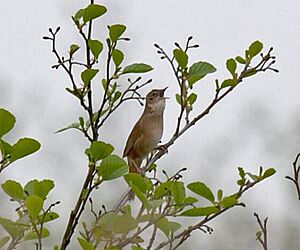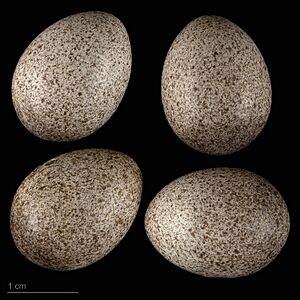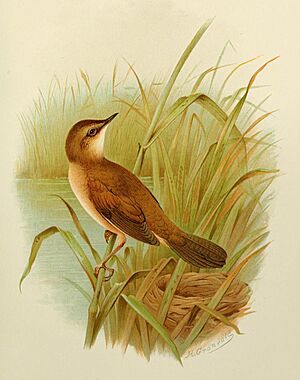Savi's warbler facts for kids
Quick facts for kids Savi's warbler |
|
|---|---|
 |
|
| Conservation status | |
| Scientific classification | |
| Genus: |
Locustella
|
| Species: |
luscinioides
|
 |
|
| Range of L. luscinioides Breeding Passage Non-breeding | |
The Savi's warbler (Locustella luscinioides) is a small bird that lives in Europe and western Asia. It's a type of Old World warbler known for its unique song. This bird travels long distances, flying to northern and sub-Saharan Africa for the winter.
You can usually find Savi's warblers in reed beds, which are areas with tall grass-like plants, often near water. They build their nests in these reeds and lay three to six eggs. This bird has a plain grey-brown back and whitish-grey belly. Unlike some other warblers, it doesn't have stripes on its throat. Both male and female Savi's warblers look alike, but young birds are a bit more yellow underneath. Like most warblers, they eat insects. Even though they aren't shy, they can be hard to spot in the thick reeds, unless they are singing.
Their song sounds like a steady, mechanical, insect-like buzzing. It's often heard when the sun is setting. This song is similar to other birds in its group, but it's usually faster and deeper. It even sounds a lot like a Roesel's bush-cricket.
Contents
About the Savi's Warbler Name
This bird is named after Paolo Savi, an Italian bird expert. He wrote important books about birds in Tuscany, Italy. In 1821, Savi found some new birds that had plain, dark, reddish-brown feathers. He described them fully in 1824, and that's how the bird got its common name, Savi's warbler.
The scientific name, Locustella, comes from a Latin word meaning "little grasshopper." This is because the song of some birds in this group, like the common grasshopper warbler, sounds like a grasshopper. The second part of the name, luscinioides, means "resembling a nightingale."
Savi's warbler is closely related to the river warbler. Studies of their DNA show they are also related to the lanceolated warbler and the common grasshopper warbler.
There are three main types, or subspecies, of Savi's warbler:
- Locustella luscinioides luscinioides lives in Central and Eastern Europe, Spain, Portugal, and North Africa. It spends winter in West Africa.
- L. l. sarmatica is found in Ukraine and parts of Russia. It winters in Northeastern Africa.
- L. l. fusca lives from Jordan and Turkey all the way to Central Asia. It spends winter in Sudan and Ethiopia.
What the Savi's Warbler Looks Like

The Savi's warbler has a dark reddish-brown back that is all one color. Sometimes it has a slight green tint. It has faint light stripes above its eyes and dark areas near its beak. Its beak is thin and brown, and its eyes are also brown.
Its chin, throat, and belly are a whitish-buff color. The rest of its underside is sandy brown. During the breeding season, its feathers look a bit lighter. The bird's legs are brown. A Savi's warbler is about 14 cm (5.5 in) long.
The song is a fast, vibrating sound, much like the grasshopper warbler's song. However, it's a little lower in pitch and not as long. Before the trill, you might hear a few soft ticking sounds that slowly blend into the song. The bird sings from the top of a reed, with its beak open and throat vibrating. Both male and female Savi's warblers sing.
Savi's Warbler Behavior
Before returning to their summer homes, Savi's warblers change their feathers to their breeding plumage. When they arrive at wetlands, they usually flit around among the reeds and plants. They are hard to see. But once they claim their territories, they climb to the top of reeds and sing loudly.
They eat insects like flies, beetles, moths, grubs, and damselflies. They are also thought to eat small worms. After they finish breeding, the birds spread out to areas with less dense plants. They change their feathers again for winter and then begin their long migration. Not much is known about their habits in their winter homes. However, they live in similar swampy areas. They have also been seen in cornfields and might feed and rest in small groups.
Savi's Warbler Reproduction
The breeding season for Savi's warbler begins in mid-April in warmer areas. In Northern Europe, it starts at the end of May. The first male birds to arrive pick the best territories. These spots are usually where the reeds and sedges are thickest. As the female birds arrive, they choose mates with the best territories. Birds that arrive later get poorer quality territories. This often means they have fewer successful broods of chicks.
The female builds the nest on a small platform of reeds. It's like a moorhen's nest and is hidden well among dead reeds and plants. The nest is often made from leaves of Glyceria plants. Some nests are neatly lined with fine grasses and leaves. You usually can't see the nest from above.
The female lays four to six eggs, but sometimes only three. The eggs are greyish-white with many greyish-rusty spots. Sometimes the spots form a darker band around the egg. Each egg is about 19.5 by 14.5 mm (0.77 by 0.57 in). The female sits on the eggs for about twelve days to keep them warm. She also feeds the chicks when they first hatch. The male helps feed them as they grow bigger. The young birds are ready to fly in about twelve days. Savi's warblers usually have two broods of chicks each year.
Where the Savi's Warbler Lives
Savi's warblers breed in many countries, including Algeria, Spain, France, Italy, Germany, Poland, Turkey, and parts of Russia. They spend their winters in Algeria, Morocco, Sudan, and Ethiopia. They are sometimes seen as visitors in places like the United Kingdom, Ireland, and Belgium.
You can find Savi's warblers in reed beds, marshes, and lagoons. These places have reeds, sedges, and other marsh plants, sometimes with scattered willow trees or bushes. The bird climbs up plant stems to sing where it can be seen. But otherwise, it's hard to spot as it moves quickly through the thick plants. It rarely comes out into open areas. In their winter homes, they live in similar wet places. They might also be found in fens or marshy spots with open water, away from dense reeds.
Savi's Warbler Population Status
The IUCN (International Union for Conservation of Nature) says that the Savi's warbler is a species of least concern. This means it's not currently at high risk of disappearing. This is because there are many Savi's warblers, and they live in a very large area.
In Europe, there are an estimated 530,000 to 800,000 breeding pairs. This means there are about 1.6 to 2.4 million individual birds. Since Europe makes up about two-thirds of their total range, the world population might be between 2.1 and 4.8 million birds. The number of birds might be going down a little, but not enough to put the Savi's warbler in a higher risk category.




